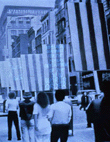| |
 Mike Stevenson, from
Artforum, 1981, doctored
magazine, 1997
|
Contact with aliens is not what it used
to be. Sightings of flying saucers in the 1950s reflected
a Cold War culture. Tall blonde Venusians stepped out of
their spaceships to preach anti-nuclear messages of
universal brotherhood to American farmers. Despite their
pseudo-religious warnings, the aliens were generally
friendly and often invited contactees to ride in their
spaceships for tours of Mars or Venus. However, by the
1980s friendly alien encounters were increasingly
replaced by unexplained abductions, medical examinations,
rapes and tortures by evil-looking silver creatures with
bulbous heads. Such accounts have entered popular
consciousness while t.v. series like the X-Files have
helped cement a fascination in deep dark secrets and
conspiracy theories. Mike Stevenson and Ronnie van Hout's
"PreMillennial - Signs of the Soon Coming
Storm" opened up a contemporary world in ruins, with
evil empires and aliens behind every facade. For this
exhibition, Stevenson took as his source material
blown-up pages from journals such as Artforum, Art+Text
and Time featuring the work of Jeff Koons, Cindy
Sherman, Daniel Buren and others. Each was lit by an
ultra-violet light, revealing hidden slogans within the
work: "All that glitters is gold", "The
established order of ages looks favorably on our
endeavors", and "666". Stevenson's
avant-garde is presented as a facade behind which lurks a
right-wing power; subversive but with ultimately sinister
intent. He "uncovers" the repressed truth about
contemporary art and reveals it to be a vehicle for evil
empires plotting to take over the world.
Stevenson plays on the anxieties of an artworld that
distrusts appearances. There is widespread belief in the
general public that viewing art is a form of decoding in
which various levels of meaning are only available to
initiates. For many people "out there", most
contemporary art could well have been created by aliens
(after all, they did build the pyramids). Disrupting the
hermeneutics of suspicion (the tradition of Marx, Freud
and Nietzsche), Stevenson playfully uncovers the hidden
truths behind the surface. If, following
poststructuralism, there are no "true
essences", Stevenson indicates that reading art is
about the mastery of meanings. It's a question of who
does the defining.
In the next room, Ronnie van Hout presented a series
of UFO drawings juxtaposed with photocopies of his
unemployment documentation from the New Zealand Labour
Department. Scattered around the room on plinths were
painted plastic models, tiny dioramas depicting the
debris of war. These latter fragments constituted a
virtual world that was never whole. Always coming before
the Millennial, art is always already in ruins, already
"failed". Van Hout's unemployment documentation
suggest the role of the contemporary artist; essentially
unemployable, not "useful" or productive but a
creator of ruins.
Western consciousness continues to fear the unknown,
which is always the unknowable. With the apocalypse
always just around the corner, van Hout and Stevenson
analyse contemporary paranoid fantasies of the unknown.
The capitalist artworld of Mike Stevenson preys on
people's insecurities, creating anxiety and paranoia. Van
Hout's mini dioramas remain frozen moments in a ruptured
world in which God has died and the aliens have landed.
"PreMillennial" presents a paranoid circuitry
of desire in which the dark logic of the mind produces
suspicion and anxiety within the ruins of modernity.
D J Huppatz
1997
© The artists and 
Courtesy of the artists
& ACCA.
|